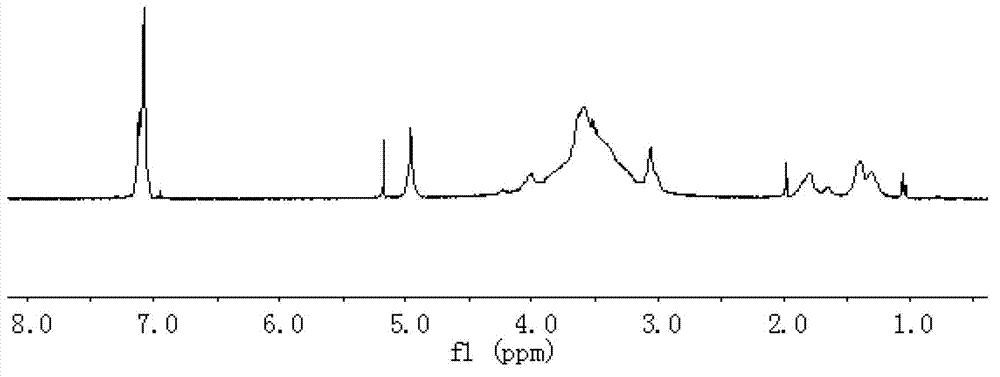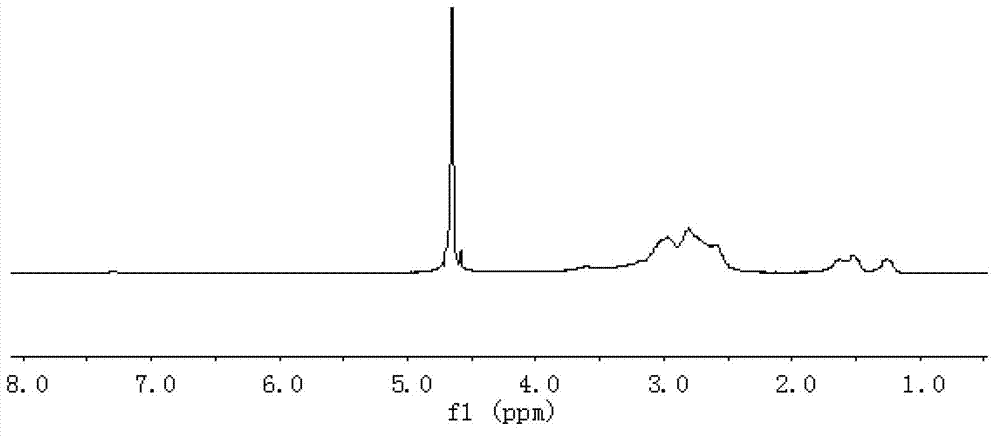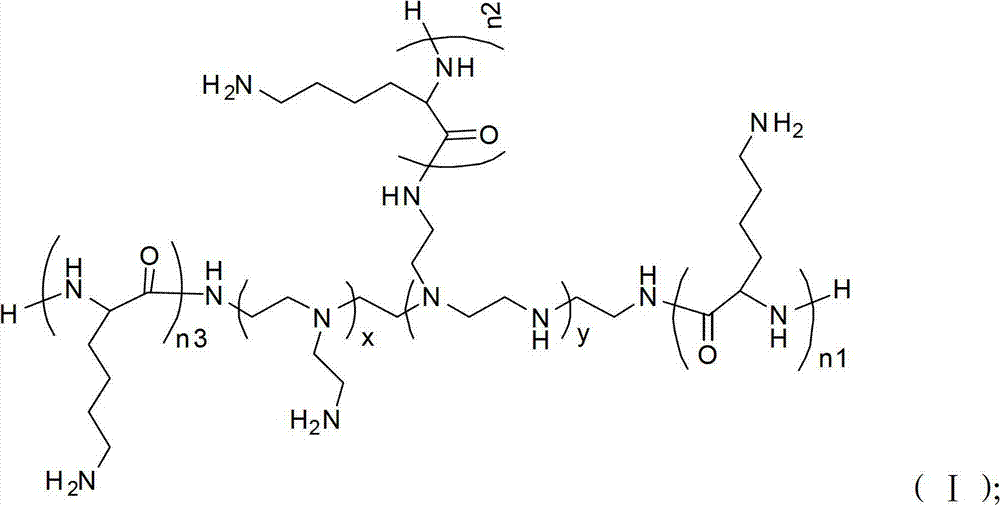Polyethyleneimine-polylysine copolymer and preparation method thereof
A technology of polyethylenimine and polylysine, applied in other methods of inserting foreign genetic materials, recombinant DNA technology, etc., can solve the problem of low vector transfection rate, reduce cytotoxicity, promote transfection efficiency, easy to create effects
- Summary
- Abstract
- Description
- Claims
- Application Information
AI Technical Summary
Problems solved by technology
Method used
Image
Examples
preparation example Construction
[0034] Regarding the polyethyleneimine-polylysine having the structure of formula (I), the present invention also provides its preparation method, which specifically includes the following steps:
[0035] Copolymerizing polyethyleneimine and ε-benzyloxycarbonyl-L-lysine N-carboxylic acid anhydride in the first organic solvent to obtain polyethyleneimine polyε-benzyloxycarbonyl-L-lysine copolymer;
[0036] The hydrogen chloride solution, the second organic solvent and the polyethyleneimine polyε-benzyloxycarbonyl-L-lysine copolymer are mixed, and the polyethyleneimine-polylysine copolymer is obtained after reaction.
[0037] According to the present invention, the ε-benzyloxycarbonyl-L-lysine N-carboxylic acid anhydride (lysine-NCA) is extremely sensitive to oxygen and is easily oxidized in an aerobic environment. in an anhydrous environment. The present invention has no limitation on the order of adding the polyethyleneimine, lysine-NCA and organic solvent, and the polyethyle...
Embodiment 1
[0043] Embodiment 1: the preparation of polyethylenimine-polylysine
[0044] 1) Under anhydrous and oxygen-free conditions, put ε-benzyloxycarbonyl-L-lysine N-carboxylic acid anhydride (Lys(z)-NCA) and chloroform in a dry reactor according to the ratio of 1g:50mL , filled with nitrogen protection, stirred to dissolve; then branched polyethyleneimine was dissolved in chloroform as a polyamine initiator, and added to the reactor, wherein the ratio of polyethyleneimine to chloroform was 1:40; temperature control Stir and react at 0~50°C for at least 12 hours. After the reaction is completed, settle in ether, filter, and dry the filter cake to obtain polyethyleneimine polyε-benzyloxycarbonyl-L-lysine copolymer.
[0045] 2) Dissolve the obtained polyethylenimine polyε-benzyloxycarbonyl-L-lysine copolymer in an ice bath with trifluoroacetic acid, add hydrogen bromide in acetic acid solution for deprotection, and carry out the reaction in an ice bath for 2 hours Above, settle with e...
Embodiment 2
[0049] In vitro transfection of HeLa cells with pGL3 (luciferase plasmid), pEGFPN1 (green fluorescent protein plasmid) and pCMV-lac Z (β-galactosidase plasmid) mediated by polyethyleneimine-polylysine
[0050] (1) Human cervical cancer cells (HeLa cells) were taken and cultured continuously in culture medium containing 10% calf serum (5% CO 2 , 37°C incubator).
[0051] (2) In vitro transfection
[0052] Within 24 hours before transfection, cells in the logarithmic growth phase were collected, digested with trypsin and diluted with Dulbecco’s modified Eagle’s medium at 1×10 per well. 4 Cells were seeded in 96-well culture plates at a density of 37°C in an incubator containing 5% carbon dioxide by volume and continued to culture until the confluence reached 80-90%. During transfection, the culture medium in the cell culture plate added the day before was discarded, and after washing twice with phosphate buffer, the complex particles of genome transfection and Dulbecco contain...
PUM
 Login to View More
Login to View More Abstract
Description
Claims
Application Information
 Login to View More
Login to View More - R&D
- Intellectual Property
- Life Sciences
- Materials
- Tech Scout
- Unparalleled Data Quality
- Higher Quality Content
- 60% Fewer Hallucinations
Browse by: Latest US Patents, China's latest patents, Technical Efficacy Thesaurus, Application Domain, Technology Topic, Popular Technical Reports.
© 2025 PatSnap. All rights reserved.Legal|Privacy policy|Modern Slavery Act Transparency Statement|Sitemap|About US| Contact US: help@patsnap.com



